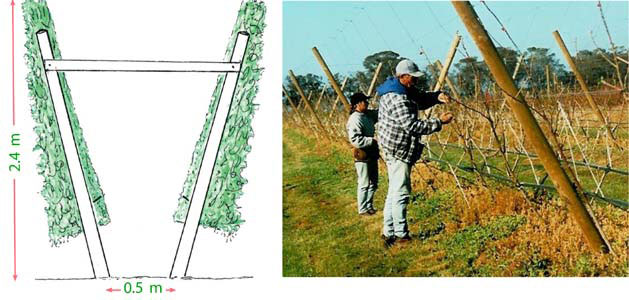Orchardists everywhere discover that the V-shaped canopy has the best prospect of improving yield, fruit quality and profitability.
V-shaped canopies
Fruit trees with V-shaped canopies were found to be most efficient in capturing a high proportion of sunlight with a reasonable and affordable tree density, and converting the sun’s energy into fruit.
V-shaped canopies if managed well, also allow good distribution of sunlight for the development of strong buds, good skin colour, even fruit maturity and good flavour.
From Tatura Trellis to Open Tatura
For more than 35 years the Tatura Trellis has increased in popularity as an orchard system for growing pome and stone fruit. From the Tatura Trellis evolved the Open Tatura.
The unique features of the Open Tatura are:
A high percentage of light interception is reached early in the life of the orchard because you can plant large trees, which fill their allotted space quickly and the number of fruiting units per hectare is maximised as soon as possible.
High early yields come from trees planted at an affordable density. Large custom-grown trees of high quality are used, so that the tree structure can be rapidly developed with many soft fruiting branches or laterals.
The permanent structure of the tree is simple and uniform. After one year in the orchard, trees have occupied all or most of their space, require little pruning in winter and are lightly cropped in the second year.
Growth and cropping are balanced because of early bearing and restricted development of roots.
The trellis is open for better light distribution and easy access to trees. The fruiting units are arranged in a manageable way which favours light penetration and facilitates pruning, thinning and harvesting.
The angle of 35 degrees in the V conforms to the upright growth habit of the trees. Tree canopies are continuous, thin, uniform and two-dimensional.
Roots are crowded for control of vigour but trees above ground are not crowded.
Almost the entire canopy can be managed from the ground.
Most orchard operations can be carried out with lightweight cost-effective equipment and allows the development of more efficient spray technology and ground cover control.
The crop can be managed per unit of canopy surface area for yield and quality consistencies.
Control of climate and bird damage can be cost-effective. Wind, hail, sunburn, and birds are constant worries and can have major impacts on consistency of production and the profitability of the orchard.
The high investment cost of the Open Tatura, and the potentially high returns and high pack-outs, often justify the installation of anti-hail and anti-sunburn netting.
It has been discovered that netting the orchard also resulted in a better skin finish of the fruit.
Markets in Australia and overseas demand a consistent supply of fruit of high quality. For most orchardists only netting can guarantee this.
Labour friendly
The Open Tatura is labour friendly because:
The most pressing problem of orcharding in the 21st century is how to obtain skilled workers to train and maintain the trees, and good pickers to harvest the fruit. It has been proved that if you have a labour-friendly orchard, you stand a good chance of attracting workers.
The structure of the tree is simple and training of the trees is easy to teach.
Most of the canopy can be reached from the ground.
Many of the tree management operations can be done by contract because the canopy is uniform. Jobs such as pruning in winter and thinning are done better because the fruiting units have been arranged in a thin and uniform layer.
Pickers make more money because a large proportion of fruit can be harvested from the ground and the fruit ends up in the bin in good condition.
By avoiding the use of ladders or platforms in the orchard you can significantly reduce the cost of labour per unit of production.
This article is from the Orchard Manual: Apple on Open Tatura
See this article in Tree Fruit Sept 2022






















